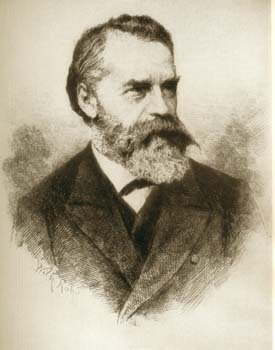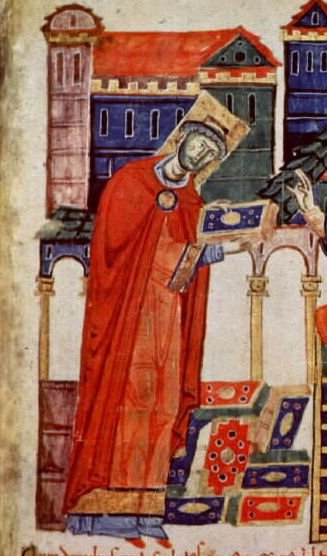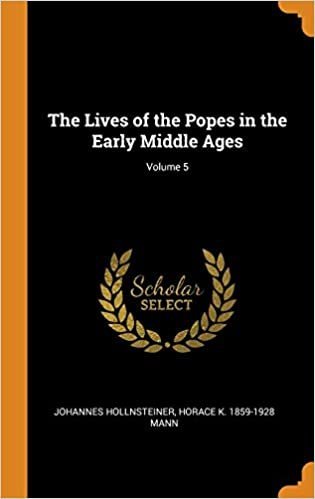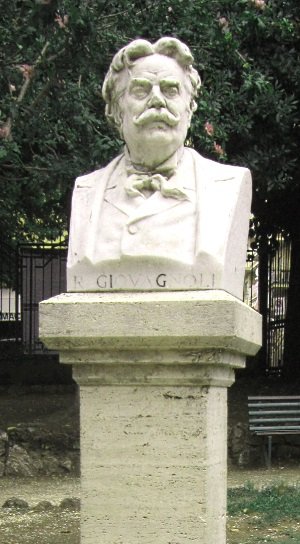The purpose of this book was never to provide a completely accurate account of the events of this period. There is too little reliable source material for that. I simply hoped to provide an entertaining story that was both coherent and reasonably consistent with known facts and scholarly judgments.
In 2003 or 2004, while an obsession with papal history was beginning to consume my attention, I noticed that the name Benedict IX appeared three times on the official list of popes. No other name was there more than once. I already understood that medieval pontificates differed greatly from modern ones. The primary responsibility of the popes in the Middle Ages was to rule a fairly large region in central Italy with—believe it or not—no standing army and no set process for selecting a new ruler when the previous one died. Even so, it was difficult to imagine a scenario in which a pope would be listed twice, much less three times. The job has always been a lifelong gig, and there has never been a canonical mechanism for recalling or impeaching a pope. So, to be listed more than once a pontiff would apparently need to be deposed or resign and then regain the papacy.
However, if a legitimate pope was deposed and then regained his throne, how could the interim pope possibly be considered legitimate? On the other hand, very few popes have ever resigned. If one resigned, there must have been a very good reason. What circumstances could drive a man who quit a lifetime job to seek it again? And what are the chances that these very unusual circumstances happened twice to the same man?
I dove into the details of Pope Benedict's life. The water was shallow. Very few people in Italy in that era could read or write, and most of those who wrote had little or nothing to say about Pope Benedict IX. These “facts” are what I discovered:
- Theophylact of Tusculum was reportedly only eleven years old when he became Pope Benedict IX.
- His immediate predecessors were his father's two brothers! Both were by all accounts rather good popes, but some earlier pontiffs from his family were not judged as favorably. The phrase “pornocracy” has been used to describe the period dominated by the family.
- Benedict IX's first pontificate ended when a rival mustered an army to oust him in his thirteenth year on the throne. Benedict's supporters quickly regrouped and forcibly reinstated him less than two months later.
- The second pontificate ended when Benedict IX resigned in order to marry the daughter of a count! Benedict somehow arranged for a cardinal to pay him a lot of money to take his place as pontiff!
- Something must have disrupted his marriage plans either before or after the ceremony. No one seems to know the details, and very few have even speculated on this event that is absolutely unique in the two millennia of Church history.
- The pope who bought the papacy resigned in disgrace after a year and a half.
- The next pope, elected at the direction of Henry III, King of Germany and future Holy Roman Emperor, died within ten months.
- At that point Benedict's supporters seized the papacy again without resorting to force.
- The third pontificate was ended by a coup engineered—at the insistence of the Holy Roman Emperor—by the Margrave of Tuscany, who a few months earlier had been a strong supporter of Pope Benedict.
- In total, Benedict served as pope for approximately as long as FDR served as president. No other pope in the tenth or eleventh century served as long.
- Commentators seemed to agree that throughout this period Pope Benedict was a degenerate who engaged in every perversion known to man. He also reportedly employed witchcraft or was in league with the devil or demons. Here is an excerpt from his current Wikipedia entry:
Ferdinand Gregorovius, a historian otherwise severely critical of papacy, wrote that in Benedict, “It seemed as if a demon from hell, in the disguise of a priest, occupied the chair of Peter and profaned the sacred mysteries of religion by his insolent courses.” Horace K. Mann calls him “a disgrace to the Chair of Peter”. He was the first pope rumored to have been primarily homosexual. Pope Victor III, in his third book of Dialogues, referred to “his rapes, murders and other unspeakable acts of violence and sodomy. His life as a pope was so vile, so foul, so execrable, that I shudder to think of it.”
At this point I knew most of the details, many of which astounded me. I had attended Catholic schools for twelve years, and I never heard of anything vaguely like this. Indeed, the nuns and priests taught us that there was an “unbroken chain” of popes starting with St. Peter right up to the current resident of the Vatican. After I dug a little deeper, some things became a little clearer:
- The primary source for #1 and #11 above (the pope's age and his scandalous behavior) was a monk named Peter Damian. The Roman Church considers him a saint despite the fact that he was never canonized by anyone except by Dante Alighieri, whose Paradiso did not appear until more than two centuries after his death. More than 500 years later Peter Damian was named a Doctor of the Church by Pope Leo XII.
- Desiderius (Pope Victor III, quoted above) was, like Peter Damian, a cloistered monk. He became associated with the popes described in Chapter 12—Leo IX, Victor II, and Stephen IX—as well as Alexander II and Nicholas II. On his deathbed Hildebrand, the future Pope (and Saint) Gregory VII, who masterminded all of these pontificates, designated Desiderius as his successor.
- I found no indication that Peter Damian was ever in or near Rome when Benedict IX was pontiff. He became a monk in 1035 and seldom left the remote monastery of Fonte Avellana, on the other side of the Apennines, about 250 miles from Rome.
- No respectable modern historian believes that Theophylact was as young as eleven when he became pope. It is too hard to reconcile that claim with more reliable information from other sources. Of the historians who care, most now estimate that he was about twenty.
- Modern historians have noted that the criticism of Pope Benedict's behavior were, aside from the writings of Peter Damian, confined to works written well after the pontiff's demise.
- It seemed quite clear to me that in the eleventh century the papacy had been wrested from the Romans by Hildebrand's followers and the Holy Roman Emperor. This led to a string of popes who were foreigners or, after the alliance crumbled, monks. These popes implemented “reforms”, among which was a canon that allowed each of them to designate the men (cardinals) who elected the next pope. Thenceforth the people of Rome have had no say in the selection of the Bishop of Rome.
Historians now agree that Peter Damian's estimation of Pope Benedict's age was way off. What if he was also mistaken about Pope Benedict's behavior? His information was second-hand. Maybe his Roman informant(s) lied to him; maybe they exaggerated or drew hasty conclusions; maybe Peter Damian just misunderstood. If the pope's behavior was so outrageous, why was a cloistered monk 250 miles away the only person who denounced him at the time?
Discounting Peter Damian's attributions helps to explain the most puzzling mystery of the most puzzling pontiff: how could the most reviled pope of the eleventh century also enjoy the longest and most placid tenure of any pope in that century? It would also explain why his policies and rulings were seldom challenged in the chronicles of the period. All the criticisms focus on his alleged behavior.
Starting with the assumption that Benedict was a reasonably successful pope, who, like all rulers, needed to deal with opposition within his realm, makes it easier to appreciate how he could have been forced out at one point and then managed to reclaim the throne rather quickly. A strikingly similar scenario occurred in the pontificate of another member of the Tusculan clan, Pope John XII. In that case, however, the interim pope was never considered legitimate[1] even though Pope John had much more difficulty reclaiming his throne.
On the other hand, no precedent exists for Pope Benedict's bizarre resignation and his equally strange return to power. Sources agree that he intended to marry and that his betrothed was the daughter of Count Gerard, a loyal ally of the Tusculans. There is some disagreement about whether the count was from Galeria, an extinct village north of Rome, or Saxo, parts unknown. Horace Kinder Mann claims that there were two brothers—Count Gerard of Galeria and Girard of Saxo. Since I could not fathom why anyone with two sons would name them Gerard and Girard, I merged them into one Count of Saxo. I located his castle near Galeria north of Rome.
I had to invent a name and personality for the daughter and a way for the marriage plans to disintegrate after a few months. Divorce was out because the Church has never approved it, and it was illegal in Italy until 1970. I also needed to concoct a situation in which Benedict could come storming back to power along with an explanation for why it took him over two years.
Someone in Rome must have been the source for the influential rants of Peter Damian and Victor III. Hildebrand was the obvious choice. If Benedict was actually twenty when he was elected pontiff in 1032, Hildebrand, who was born in 1020, would have been at least 24 at the end of Benedict's first pontificate. He was a Roman who has been described as Peter Damian's friend. He was also very close to Desiderius, the monk who became Pope Victor III.
Another major invention was needed to explain how and why one family came to dominate papal politics over several generations. I concocted a conspiratorial relationship between the saintly monks of Grottaferrata and the counts of Tusculum. This does not seem far-fetched to me. Grottaferrata and Tusculum are close neighbors, or they would be if Tusculum had not been leveled by an army sponsored by Rome—then ruled by Pope Celestine III—on April 17, 1191. It is also well established that Count Gregory financed the monastery's construction and that Benedict IX also contributed to it. I was thrilled to learn that Benedict IX corresponded with the hegumen even after his downfall.
Most of the rest of the plot was dictated by documented events of the day. All of the pilgrimages to and invasions of Italy that are mentioned actually occurred. Most of the named characters really lived during this period. That includes all the popes and antipopes, cardinals, kings, emperors, and their wives. Fr. Lawrence was indeed a protégé of Pope Sylvester II, and he actually ran a school in Rome that was attended by Gerhard Brazutus, Theophylact, and Hildebrand ("the Toad"). Whether Theophylact and Hildebrand were there at the same time is at least possible. Bishop Wipo was real; Rudolph was concocted. Everyone in Theophylact's family except for Costanza is fairly well documented. I fabricated everything about Costanza and Tigra. Pope John XII's diary is an invention, but the story aligns with Liutprand's account. St. Boniface the Younger really was the hegumen, but Brother Clement and Brother Alexius are my inventions. The two horses are imaginary. Casimir was definitely real. Cluny is real.
The character of Gerard is based on Gerhard Brazutus, who was allegedly a practitioner of the black arts, an assassin, and Theophylact's friend. Not much more is known of him. The primary contemporaneous source of information is Cardinal-Bishop Beno. Unfortunately, there is no record of Beno's date or place of birth, but he was prominent during Hildebrand's pontificate (1073-1085).
The footnotes are, to the best of my knowledge, completely accurate.
I must apologize for my depiction of the protagonist, Theophylact/Longino/Paul/Pope Benedict IX. The two fictional characters that I admire the most are Gus McRae in Larry McMurtry's epic western, Lonesome Dove, and Kirth Gersen, the monomaniacal hero of Jack Vance's sci-fi pentalogy, The Demon Princes. These guys were exceptionally cool, but poor Theophylact, as he portrays himself in the text, resembles neither of them in any way. I did not intend for him to come across as a wimpy egghead. The plot just seemed to require it at every turn.
Maybe someday Professor Thomasson will discover the text for the lacuna that disrupted the account of his pilgrimage, and Theophylact will get a chance to show what he could do with the sword and bow that he hid on the mule.
I settled on the ending endorsed by The Catholic Encyclopedia. It asserts that the former pontiff took monastic vows and died of natural causes at Grottaferrata. I did this in spite of what I learned from Santo Lucà, the scholar who discovered a conversation between Theophylact and Hegumen Bartholomew in the scholia of an ancient text. I asked him in an email whether he thought that Theophylact might have retired to the abbey in Grottaferrata, his response was terse: “Assolutamente no.”
Mike Wavada
March 4, 2025
[1] The interim antipope was elected pontiff after John XII died. He appears on the official list as Leo VIII. Throughout Church history there are numerous other inconsistent decisions concerning which men who had performed the functions of Supreme Pontiff were considered legitimate. In fact, as late as the twentieth century two names that were on the list for over one thousand years were removed!







